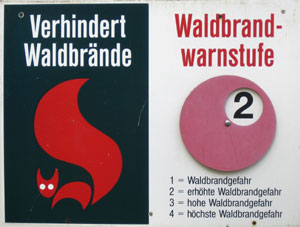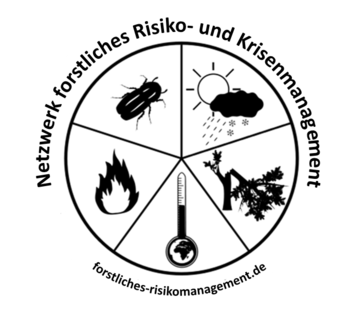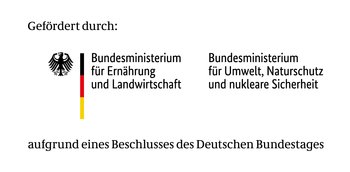Almost all forest fires are caused by the careless actions of people. As discarded, still burning cigarette butts and carelessness with open fires are the main causes of forest fires, there are special rules concerning fires in forests. Through conscientious and careful behaviour, every forest visitor can do his or her bit to protect forests from fire.
In fire risk regions, forest visitors are informed about forest fires, rules of behaviour and the actual forest fire risk level via information signs in rest areas and walkway car parks. The actual forest fire risk is also provided online by the German weather service or the state and also reported via local press and radio.
Open fires and smoking in forests

Fig. 1: Notice board in Mecklenburg-Western Pomerania. (Photo: Burts/wikipedia.de)

Fig. 2: Smoking ban in forests: Rules vary depending on federal state.
(Montage: FVA/S. Haas, Forest photo: FVA/H. Gössl)
The legal regulations relating to fires in forests vary between the different federal states. As well as federal forest laws, special forest fire prevention regulations apply in some areas at risk from forest fires. For example there is a year round smoking ban in the forests of Brandenburg and the Rhineland Palatinate and a partial ban in Baden-Württemberg’s forests. In Mecklenburg-Western Pomerania smoking in forests is only allowed in specially dedicated smoking areas.
A similar situation applies to dealing with open fires. Each state has its own statutory regulations. If the forest fire danger is very high, then entering a forest on foot or by vehicle can be prohibited in the interests of fire prevention. In Brandenburg and Mecklenburg-Western Pomerania this can occur above the forest fire warning level 3.
As well as fire regulations it is just as important to keep access ways to forests clear so that in the case of a fire, fire fighters have unobstructed access to the site. If cars are parked in or near forests, care has to be taken that they are not parked on a flammable surface (e. g. dry grass). A car’s hot catalyser can cause a fire to start.
It has not been proved that forest fires can be caused by pieces of broken glass, however forests should be kept clean and waste and rubbish should not be left lying around.
What can I and do I have to do in the event of forest fire?
Everyone is obliged to voluntarily provide assistance during a forest fire. Whoever spots a fire in or near a forest, can begin – without putting themselves in danger – to try and put it out. Here simple resources such as sand, earth or green branches can be used to suppress the fire. With even sweeping motions the branches are used to sweep the flames in the direction of the fire. But be careful: Beating the fire can cause sparks and the air supply can fan the flames.
If initial firefighting measures are successful and the fire is thought to be extinguished, the fire service still needs to be informed immediately as embers can burn below ground and the fire could reignite.
If the fire can not be put out, then the fire service needs to be notified as quickly as possible. The emergency number for the fire service is 112 in Germany and 122 in Austria.
The following information is needed when reporting a fire:
- Where is the fire? – exact location, significant landmarks (large tree, meadow or rocks), extent of the fire.
- What is burning? – Ground vegetation or the tree canopy?
- Are people or property in danger? – are people, houses or other facilities in danger?
- Location from where caller is reporting the fire? – Your telephone number and location you are calling from, if possible wait for the emergency services to arrive to direct them to the fire if needed.
The fire service takes over the work of extinguishing the fire when they arrive at the location of the fire. Further information about fighting a forest fire can be found in the "Forest fire fighting" article in the Forest Fire Handbook.
Literature
- Caspers, G. (2000): Waldbrandschutz. CD-ROM. aid.
- Landesforst Mecklenburg-Vorpommern (1999): Durchführungserlass zum Gemeinsamen Waldbrandrunderlass des Ministerium für Landwirtschaft, Umwelt und Verbraucherschutz und Innenministeriums. Lesefassung 15. Juni 2009
- Ministerium für Ländliche Entwicklung, Umwelt und Verbraucherschutz des Landes Brandenburg [Hrsg.] (2009): Waldbrandschutz in Brandenburg – Früherkennung und Überwachung mit System. Broschüre, Potsdam
- Müller, C.; et al. (2000): Waldbrandschutz - Manuskript der Bund-Länder-Arbeitsgruppe Waldbrandschutz. in Caspers, G. (2000): Waldbrandschutz. CD-ROM. aid.
- Schretzmann, Rainer (2001): Waldbrandschutz - eine wichtige Information zum richtigen Verhalten im Wald. aid 1354/2001.
- Verordnung zur Verhütung und Bekämpfung von Waldbränden im Land Mecklenburg-Vorpommern (Waldbrandschutzverordnung)
Forest Crises Management Advisory Guide
Back to the main page of the Forestry Crisis Management Advisor Guide: Overview of the different topic collections
Back to the article overview in the: Forest fire Topic Collection


